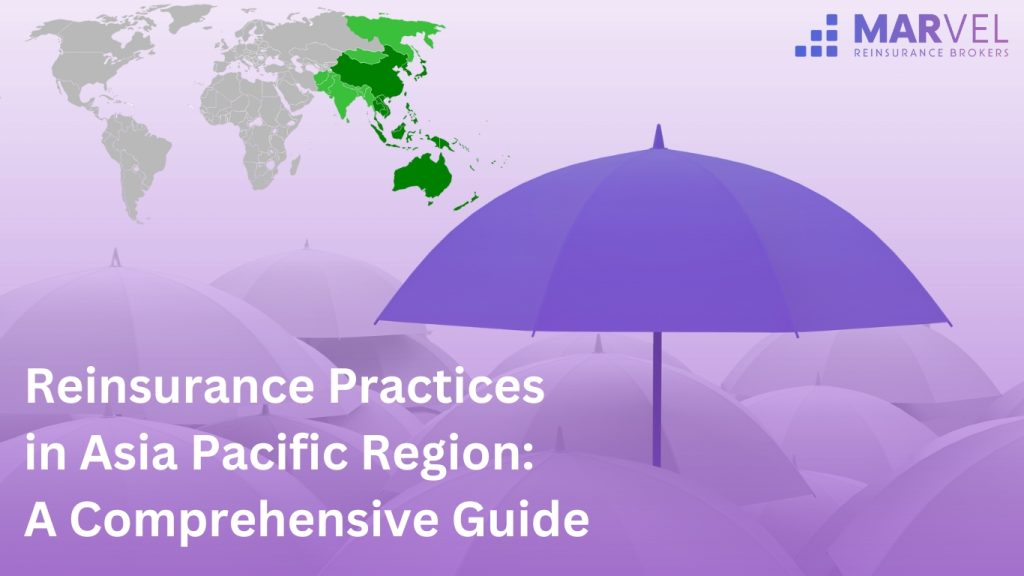
Introduction
Reinsurance plays a crucial role in the insurance industry by allowing insurers to effectively manage risk, stabilize their financial records, and increase their underwriting capabilities. In the Asia Pacific (APAC) region, practices in reinsurance have grown at a rapid rate due to economic growth, growing insurance penetration, and exposure to different risks such as natural disasters, urbanization, and emerging technologies. The Asia Pacific region is currently a global giant in the world’s reinsurance industry. Its phenomenal growth is driven by booming economies, expanding populations, and newly emerging risks like natural disasters and cyber attacks. With the region developing further, the reinsurance businesses evolve to suit local needs and global specifications. This article discovers how reinsurance functions in the region of Asia Pacific today, including its strategies, regulations, technology innovations, and future prospects for overcoming challenges.
The APAC region is diverse, featuring well-established insurance markets such as Japan, South Korea, and Australia, alongside rapidly growing markets like India, China, and the nations of Southeast Asia. Reinsurance in APAC is impacted by:
• High Natural Catastrophe Exposure: Countries like Japan, Indonesia, and the Philippines expose themselves to significant seismic, typhoon, and flood risks, which generate high catastrophe reinsurance demand.
• Urbanization and Economic Growth: Consistent economic growth in economies like China and India has increased insurance demand, necessitating robust reinsurance support.
• Regulatory Differences: The APAC region has diverse regulatory frameworks that influence reinsurance designs, capital requirements, and entry into the market.
• Technology Evolutions: Insurtech and data analytics are transforming underwriting and risk assessment, thus impacting reinsurance strategies.
Asia Pacific Reinsurance Market Growth and Dynamics
Market Size and Growth Trends
Asia Pacific reinsurance market is booming in size. The reinsurance premiums in the region have been growing by approximately 6.5% every year over the past few years, according to Swiss Re’s sigma reports. This is fueled by rising prosperity, higher insurance penetration, and a rise in natural disaster frequency. Some of the largest markets like China, India, and Australia are propelling the market share growth with tremendous increases.
Key Players and Market Share
Large reinsurance players from overseas have a broad presence in Asia Pacific. Leading organizations in the field include Munich Re, Swiss Re, and Lloyd’s. Domestic players such as IRDAI in India also have a strong hold. The big reinsurers account for about 60-70% of the market share, while the regional reinsurers fill up the remaining portion. The combination has the impact of balancing global expertise with local knowledge.
Emerging Markets and New Opportunities
Vietnam, Indonesia, and the Philippines are becoming large markets now. Their growing economies provide lots of new opportunities. The reinsurers are exploring products like cyber insurance, climate change cover, and insurtech alliances. These innovations cater to special needs in growing markets and respond to potential threats ahead.
Regulatory Environment and Its Impact on Reinsurance Practices
Regulatory Framework in Major Countries
Different countries in Asia Pacific have a different set of regulations. India’s IRDAI has strict capital conditions and rules of risk management. Similarly, Chinese regulators are also opening up markets with fresh pilot initiatives. APRA supervises reinsurers in Australia to ensure that they hold enough capital to meet claims. All of these regulations shape how reinsurance companies conduct business in each country.
Cross-Border Reinsurance Policies
Regional reinsurance is being facilitated by free trade zones and trade agreements. They eliminate entry barriers and facilitate smooth transfers across the border. But still, there are challenges such as varying laws, taxes, and currencies. Most companies address this through local alliances and documentation to secure compliance.
Recent Regulatory Changes and Future Outlook
Recent reforms, including China’s attempts to open reinsurance to greater liberalization, are designed to promote competition and attract foreign investors. As the region grows, the regulators will tend to adapt by opening up markets and ensuring increased transparency. This will further promote innovation and regional coordination.
Reinsurance Practice and Strategies in Asia Pacific
Clustered Reinsurance Strategies
Reinsurers employ primarily two methods. Proportional reinsurance is the sharing of premiums and losses as percentages, agreed upon before hand. Non-proportional reinsurance provides protection over and above a certain threshold of losses. Japan and other countries prone to natural disasters tend to prefer non-proportional methods, while others may prefer proportional contracts to ensure stability.
Catastrophe Risk Modeling and Management
Good risk modeling matters. Sophisticated software is used by companies to model risks arising from typhoons, earthquakes, and floods. Local partnerships with skilled firms add to models. Better models mean better pricing and less surprise when the worst occurs.
Innovation in Reinsurance Products
Parametric reinsurance is gaining traction. Instead of indemnity-style policies, these types of coverage pay out when a pre-agreed condition is fulfilled, for example, when a typhoon reaches a certain level of intensity. Climate change products in Japan and Bangladesh are also on the increase, allowing for communities to be ready for emerging risks from altering weather patterns.
Risk Assessment and Underwriting Standards
Local data and expertise are what reinsurers rely on. They utilize big data analytics to secure a deep understanding of risk in each market. This approach results in better underwriting decisions and fairer pricing, allowing reinsurers and direct insurers to grow profitably.
The Role of Technology and Digital Transformation
Insurtech and Digital Platforms
Computerized platforms support reinsurance business with speed and clarity. Blockchain platforms aid in tracking policies and claims, reducing errors and fraud. They help with prompt disbursement of claims, which boosts customer satisfaction.
Data Analytics and Artificial Intelligence
Artificial Intelligence supports more accurate prediction of risks. Reinsurers analyze vast amounts of data from weather forecasts, satellite images, and social media. Gathering data in real-time as it occurs in natural disasters supports decision-makers to act swiftly and efficiently.
Challenges and Opportunities
There are gaps in technology in a few nations, hindering the pace of digital adoption. Nevertheless, if the reinsurers are able to deconstruct these gaps, they will be able to gain better efficiency, more precise risk assessment, and new business models. Digital transformation is needed to prosper in the region.
Future Trends and Challenges in Asia Pacific Reinsurance
1. Climate Risk and ESG Integration
Since climate change is increasing the severity of risks, APAC reinsurers are prioritizing environmental, social, and governance (ESG) factors:
• Climate Modeling: Reinsurers are refining models to include rising sea levels, severe weather, and urban heat exposures.
• Sustainable Reinsurance: Reinsurance products supporting renewable energy projects and green infrastructure are growing, particularly in Australia and Japan.
• ESG-Linked Reinsurance: Premium rebates for insurers adopting sustainable methods are being offered by some reinsurers, as a result of global ESG momentum.
2. Cyber Reinsurance Demand
Rising cyber risks in APAC, particularly in technology-driven economies of Singapore, South Korea, and China, have spur demand for cyber reinsurance. Reinsurers are developing unique products to cover data breaches, ransomware, and business interruption, though limited historical records leave underwriting challenges.
3. Health and Life Reinsurance Growth
Aging populations in Australia, Japan, and South Korea, together with rising healthcare costs, are driving the need for life and health reinsurance. Reinsurers are offering longevity risk solutions, medical malpractice reinsurance, and critical illness covers to support primary insurers.
4. Microinsurance and Inclusive Reinsurance
Microinsurance is being disseminated to cover low-income groups in emerging markets like India, Indonesia, and the Philippines. Reinsurers are supporting such initiatives by:
• Affordable Product Development: Reinsurers provide capacity for microinsurance products covering agriculture, health, and property risks.
• NGO and Government Partnerships: Global cooperation in markets like Bangladesh and Vietnam enhances access to reinsurance for microinsurance programs.
• Parametric Solutions: Parametric reinsurance is increasingly applied to enable microinsurance, with the delivery of quick payment for smallholders and climate-affected communities.
Challenges in APAC Reinsurance
Even though it’s on the rise, the APAC reinsurance market is bedeviled by a variety of challenges:
• Underinsurance Gap: Penetration of insurance is low in emerging markets like India and Indonesia, limiting reinsurance potential.
• Data Limitations: Data variability and availability impact effective risk modeling, particularly for cyber and emerging risks.
• Regulatory Fragmentation: The divergent regulations of APAC present a challenge to setting cross-border reinsurance transactions.
• Climate Volatility: Increased frequency and severity of natural catastrophes challenge reinsurance capacity and pricing.
• Talent Shortage: Rapid growth in insurtech and complex risks require skilled underwriters and actuaries, who are in short supply in some markets.
Conclusion
Reinsurance in Asia Pacific is becoming more advanced and the regional economy continues to boom. Technological advancements, changing regulations, and the growing risk of climate change are all shaping the future of reinsurance. To be a leader means being flexible, understanding the markets in the region, and adopting new tools and techniques. Keeping up with the trends is what any business person needs to do in Asia Pacific’s fast-paced world.

